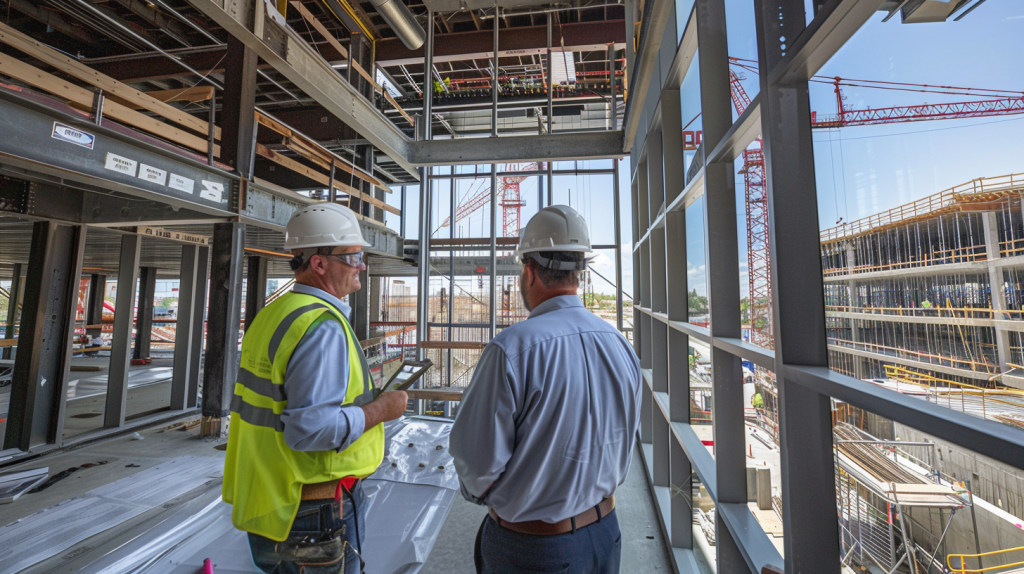The Comprehensive Guide to Effective Resource Management in Construction: Strategies and Tools
Table of Contents:
Dive into the comprehensive guide to effective resource management in construction. Discover key strategies, tools, and best practices that project managers can use to ensure efficient use of resources, from labor to materials, optimizing project timelines and budgets.
In the fast-paced, high-stakes world of construction, effective resource management is a critical component that can make or break a project. Efficiently allocating and monitoring labor, equipment, and materials not only enhances project efficiency but also reduces costs, ensuring successful project outcomes. This guide delves into the essential tools and best practices for optimizing construction resource management, helping you streamline your processes and achieve your project goals.

Why Effective Resource Management is Crucial in Construction
Construction projects are inherently complex, involving numerous tasks, resources, and stakeholders. Without a well-defined schedule and effective resource management, managing these elements can quickly become overwhelming. Effective resource management ensures that all elements of the project work together seamlessly, minimizing waste and maximizing productivity.
The Impact of Poor Resource Management
When resources are not managed effectively, the repercussions can be severe. Projects can suffer from delays, cost overruns, and quality issues, all of which can harm your reputation and bottom line. Conversely, optimized resource management can lead to smoother operations, better financial outcomes, and higher client satisfaction.
Imagine a scenario where materials arrive late, workers are idle, and equipment sits unused due to poor planning. Such inefficiencies not only delay the project but also inflate costs significantly. These issues often stem from a lack of proper planning and monitoring, leading to resource wastage and budget overruns.
Benefits of Mastering Resource Management
Mastering resource management offers numerous benefits. It enables project managers to:
- Enhance Coordination: Ensuring that all team members and stakeholders are aligned and working towards common goals.
- Mitigate Risks: Identifying potential issues early and developing strategies to address them.
- Optimize Resources: Efficiently allocating labor, materials, and equipment to maximize productivity.
- Improve Client Satisfaction: Meeting or exceeding client expectations by delivering projects on time and within budget.
Effective resource management isn’t just about avoiding problems; it’s about creating opportunities for success. By efficiently utilizing resources, you can increase your project’s profitability, improve team morale, and build stronger client relationships. Additionally, optimized resource management contributes to sustainable construction practices by reducing waste and promoting efficient use of materials.

Advanced Tools for Effective Resource Management
Utilizing the right tools is crucial for managing resources effectively in construction. These tools help project managers plan, monitor, and adjust resources efficiently, ensuring that projects run smoothly.
Resource Management Software
Resource management software is a cornerstone of modern construction projects. Platforms like StruxHub integrate various functionalities that streamline the process of managing labor, equipment, and materials. These platforms offer features such as:
- Resource Allocation: Assign resources to tasks based on availability and project requirements.
- Real-Time Tracking: Monitor resource usage in real-time, allowing for immediate adjustments.
- Forecasting: Predict future resource needs using historical data and trends.
Using resource management software, project managers can create detailed schedules, track progress, and make data-driven decisions. This not only improves efficiency but also reduces the risk of over-allocation or under-utilization of resources, ensuring that projects stay on track and within budget.
Gantt Charts
Gantt charts are invaluable for visualizing project timelines and resource allocation. They help project managers:
- Plan Resource Usage: Clearly outline when and where resources are needed.
- Monitor Progress: Track task completion and resource utilization.
- Identify Conflicts: Spot and resolve scheduling conflicts before they impact the project.
Gantt charts provide a visual timeline of the project, making it easier to manage overlapping tasks and resource dependencies. This visual representation helps project managers ensure that resources are used efficiently and that the project progresses smoothly.
Inventory Management Systems
Effective inventory management systems are essential for tracking materials and equipment. These systems help you:
- Track Inventory Levels: Monitor stock levels in real-time to avoid shortages and overstocking.
- Manage Orders: Streamline ordering and receiving processes.
- Optimize Storage: Ensure materials are stored efficiently to prevent damage and loss.
Inventory management systems reduce the risk of material shortages that can cause project delays. They also help avoid overstocking, which ties up capital and can lead to wastage if materials expire or become obsolete.
Related Articles:
Best Guide to Construction Management Software
The Best Guide to Delivery Management Systems (DMS) for Commercial Construction
45 Benefits and Tips of Construction Management Software for Superintendents

Best Practices for Efficient Resource Management
Implementing best practices is key to optimizing resource management in construction. Here are some strategies to help you make the most of your resources:
Detailed Planning and Scheduling
A well-thought-out plan is the foundation of efficient resource management. Detailed planning and scheduling help you allocate resources effectively and avoid bottlenecks.
- Create a Comprehensive Plan: Outline all tasks and resource requirements.
- Set Realistic Schedules: Develop schedules that account for resource availability and project constraints.
- Use Scheduling Tools: Utilize tools like Gantt charts and project management software to create and manage schedules.
Regularly updating and adjusting the schedule based on real-time data ensures that resources are deployed where they are needed most, minimizing idle time and maximizing productivity.
Regular Monitoring and Reporting
Continuous monitoring and reporting are essential for keeping track of resource usage and making necessary adjustments.
- Conduct Regular Audits: Regularly audit resource usage to ensure everything is on track.
- Generate Reports: Use resource management software to generate detailed reports on resource utilization.
- Adjust as Needed: Be prepared to adjust resource allocations based on real-time data and project needs.
Regular monitoring allows for timely identification of issues that could impact resource efficiency. It also provides insights into areas where improvements can be made, helping to refine resource management practices over time.
Training and Development
Investing in the training and development of your workforce can significantly enhance resource management.
- Provide Ongoing Training: Ensure your team is well-trained in using resource management tools and techniques.
- Foster a Culture of Efficiency: Encourage your team to adopt best practices and continuously look for ways to improve efficiency.
Training your team to use resource management tools effectively ensures that they can make the best use of available resources. A well-trained team is more likely to work efficiently, identify potential issues early, and contribute to overall project success.
Effective Communication and Collaboration
Clear communication and collaboration among team members are crucial for efficient resource management.
- Use Collaboration Tools: Utilize collaboration tools to facilitate communication and information sharing.
- Hold Regular Meetings: Conduct regular meetings to discuss resource management issues and solutions.
- Encourage Feedback: Create an environment where team members feel comfortable providing feedback and suggestions.
Effective communication ensures that all team members are aware of resource management plans and any changes that occur. It also fosters a collaborative environment where everyone is working towards common goals, leading to more efficient and successful projects.

StruxHub
Discover how StruxHub can revolutionize your construction management. Contact us today!
Achieving Success Through Optimized Resource Management
Optimizing construction resource management is crucial for the success of any project. By utilizing essential tools and implementing best practices, you can effectively allocate and monitor labor, equipment, and materials, enhancing project efficiency and reducing costs. This comprehensive approach ensures that your projects are completed on time, within budget, and to the highest standards of quality.
StruxHub is at the forefront of transforming construction management with its innovative, user-friendly platform designed to streamline operations, enhance on-site safety, and improve project efficiency. By integrating cutting-edge technology with practical, real-world applications, StruxHub provides a holistic solution to the complex challenges faced by today’s construction professionals. Our platform is built to ensure seamless collaboration, meticulous resource management, and unparalleled project oversight, making construction projects more manageable and predictable than ever before.
StruxHub’s Key Features and Benefits:
- Advanced Delivery Management: Automate and optimize your delivery schedules, ensuring materials arrive just in time, every time.
- Site Communication: Utilize georeferenced maps and instant messaging to keep every team member informed and aligned.
- Construction Materials Management: Track inventory levels and manage materials procurement with ease, reducing waste and avoiding project delays.
- Construction Safety & Inspection Workflows: Implement customizable mobile forms for conducting safety inspections and managing compliance documentation effortlessly.
- Short-Term Scheduling: Visualize project tasks with detailed floor plans, linking each activity to specific locations for better planning accuracy.
- Construction Resource Management: Efficiently allocate personnel and equipment, maximizing productivity and reducing idle time.
StruxHub’s Product Offering:
- StruxHub Deliveries: Simplifies the coordination of incoming deliveries, ensuring materials and equipment are precisely timed to project needs.
- StruxHub Logistics: Offers intelligent site logistics planning, from crane scheduling to space allocation, for smoother operations.
- StruxHub Safety: Elevates on-site safety standards with easy-to-use tools for inspections, permits, and incident reporting.
- StruxHub Scheduling: Enhances project timelines with intuitive scheduling tools that ensure tasks are completed efficiently and on time.
With StruxHub, construction companies can look forward to a streamlined, more efficient project execution that delivers on time and within budget. Embrace the power of innovation and take your construction projects to the next level.
Don’t miss out on the opportunity to optimize your construction management processes with StruxHub. Sign up for a free demo today. Let’s build smarter, together.



